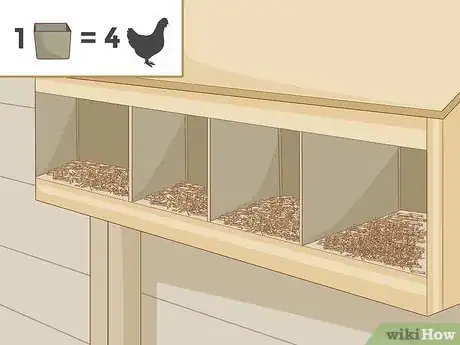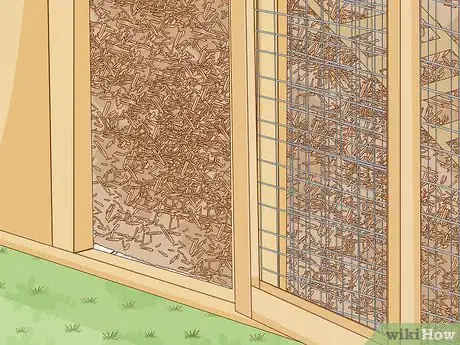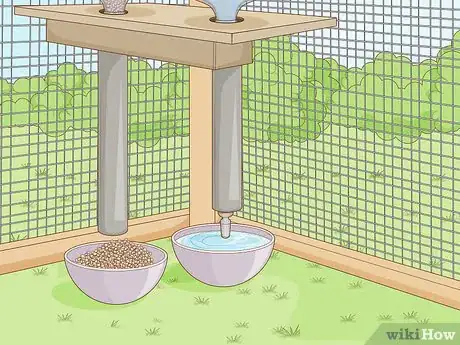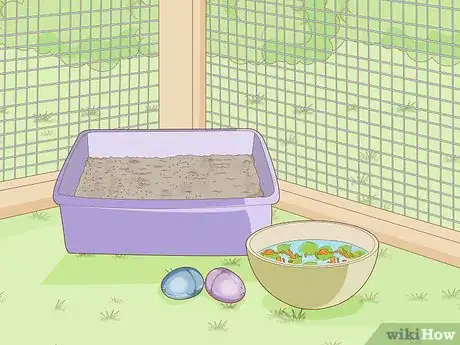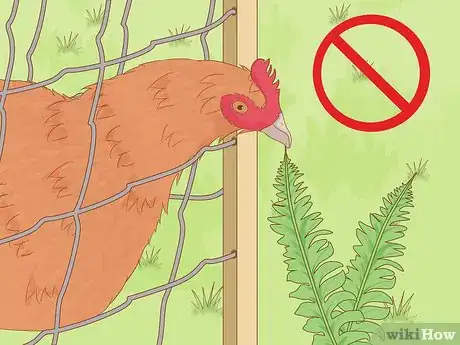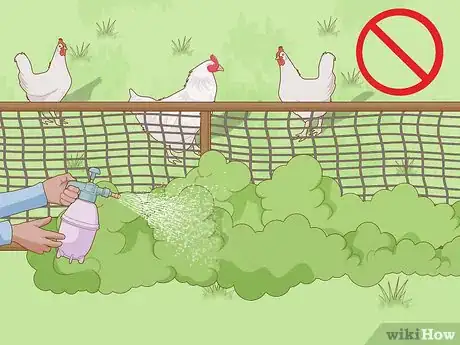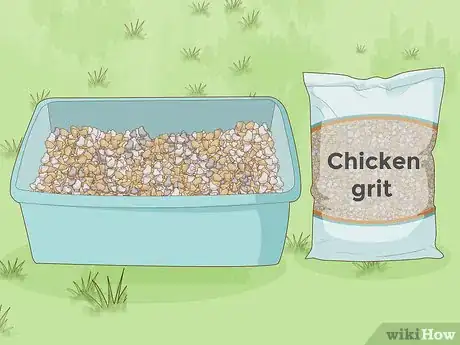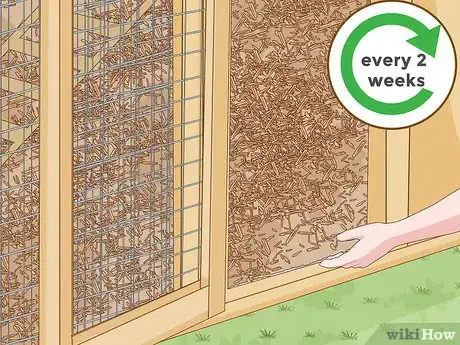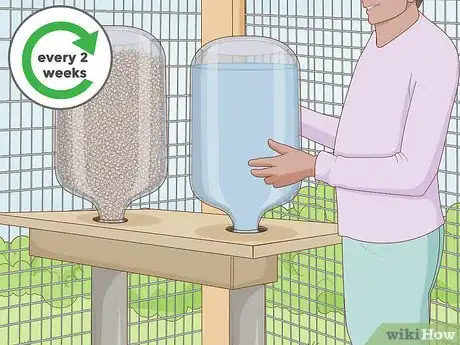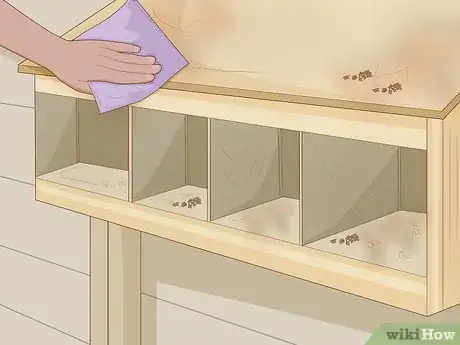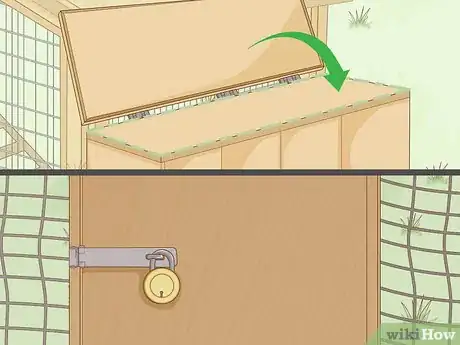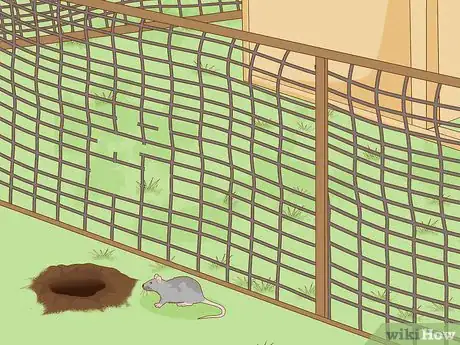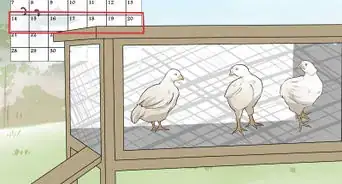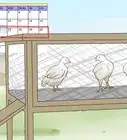This article was co-authored by Amy Harrison, a trusted member of wikiHow's volunteer community. Amy Harrison has over five years of experience working directly with poultry. She has worked on a rural chicken farm built around marketing free-range eggs, where she managed the care for the poultry year-round. She has experience breeding chickens and quail, caring for newborn poultry, handling their health issues, and managing their dietary needs.
There are 10 references cited in this article, which can be found at the bottom of the page.
This article has been viewed 61,767 times.
Learn more...
When first raising backyard chickens, you need to set up a home for the flock. The coop will be a place where the chickens have a sense of security and will roost every night. They will eat, drink, scratch, forage, bathe, talk, lay and run about in the coop. They may even choose to breed and incubate eggs. Before you can purchase your very first flock you need to first set up the coop correctly.
Steps
Setting Up the Coop
-
1Purchase a suitable chicken coop for your flock. You'll need to decide upon the size, security, run and price. The larger the flock, the larger the coop. The more expensive the coop the more secure and size. If your chickens aren't going to be free-range (let out to roam in the garden) then you need to purchase a coop with an attached run.[1]
- You can find chicken coops online, in pet shops or at nearby ranch supply stores. Second-hand coops will be found at a cheaper cost but if you have a large budget, take a look around at a pet shop in town.
- A standard chicken needs 4 square foot of floor space in the coop and 8 square foot in the run. Bantams only need half; so 2 square foot in the coop and 4 square foot in the run.
- Set up the coop once delivered. What is meant by setting up the coop is constructing it if it wasn't bought set-up already.[2]
-
2Set up nesting boxes and perches. If the coop doesn't already come with nesting boxes or if the nest boxes are limited to your flock, consider setting up some more. For every four hens there should be one nesting box. Perches are essential to coops so that the hens don't get dirtied in their own waste and can sleep during the night.Advertisement
-
3Purchase absorbent bedding. The bedding will layer the floor of the coop and possibly the nesting boxes. The bedding needs to be absorbent to soak in the waste meaning you don't have to clean the coop as often. The top bedding to use is wood shavings whilst the worse would be sand and/or newspaper.[3]
- Some people like to layer their coop with two different bedding materials such as newspaper at the bottom and wood shavings at the top to make clean up easier and the material more absorbent.
-
4Purchase nesting materials. This will go inside the nesting boxes to cushion the chickens and the eggs and for the chickens to make nests if they ever want to go broody. Hay and straw is what you need to purchase.
-
5Add drinkers and feeders to the coop. These are, like many other items, essential to the coop. Depending on your flock size you can choose upon a large drinker/feeder or a smaller one. They can be placed either inside or outside the coop/run.[4]
-
6Add additional items. Sand tubs for dust bathing, chicken toys, treat bowls, wading water tubs, etc can be added to the coop for extra fun for the chickens.[5]
Preparing the Garden
If you keep free-range chickens, it's best to prepare the garden before you bring your flock home.
-
1Set up a fencing system. Chickens do wander just like an outside cat. The last thing you want is the chickens walking across the road or ending up in the neighbours garden. Set up fencing or chicken wire for your flock to be sure that they are safe. It also keeps predators out.[6]
-
2Get rid of poisonous plants. Some plants can be toxic to chickens just like some types of foods. You can find a list by researching online. If you know what types of plants you have in your garden give them a search online.[7]
- Although chickens will avoid plants that are dangerous to them, there are always exceptions with them.
-
3Do not use chemicals or pesticides on your lawn. These are bad for chickens as they like to graze on grass often. If the chickens ingest these chemicals it can make them possibly ill.
-
4Keep a supply of grit nearby. All the foraging around the garden can be bad on the crop if you don't maintain the chickens well. Grit helps the chickens digest the nutrition they come across.
Maintaining the Coop
-
1Replace the bedding every two weeks. No matter how absorbent the bedding, it will not last forever. Waste will pile up so you will need to chuck the bedding and nesting materials and then replace them with fresh bedding/nesting materials.
-
2Clean the drinkers and feeders. The drinkers and feeders should be cleaned thoroughly every two weeks whilst they should be refilled daily to ensure that they are clean and fresh.[8]
-
3Scrub down the nesting boxes and perches. These two should be scrubbed down every two weeks or less. Waste can pile up otherwise, which is bad for the chickens.[9]
-
4Secure the coop every night. The chickens should be rounded up inside and shut in. Lock the doors and nesting box access so that no predators can sneakily make their way in.[10]
-
5Do a whole-coop secure check monthly. This is different from securing the coop every night. You're looking for holes in the coop and run, weak wood wearing away, pest infestation (such as mites, mice or termites), digging signs around the coop, etc.
Community Q&A
-
QuestionHow can I make homemade chicken feed?
 Community AnswerYou can mix cracked corn, grains, crushed eggshells and quinoa to make a homemade feed.
Community AnswerYou can mix cracked corn, grains, crushed eggshells and quinoa to make a homemade feed. -
QuestionCan I put hay in the chicken coop?
 Community AnswerYou may put hay, but be on the lookout for mites. Mites could kill your chicken, so hay is not suggested.
Community AnswerYou may put hay, but be on the lookout for mites. Mites could kill your chicken, so hay is not suggested. -
QuestionCan I use straw as bedding?
 Amy HarrisonTop AnswererStraw has a rough texture and isn't absorbent enough to be used for bedding alone. However, you can use hay to create a deep-litter method.
Amy HarrisonTop AnswererStraw has a rough texture and isn't absorbent enough to be used for bedding alone. However, you can use hay to create a deep-litter method.
Things You'll Need
- Chicken coop and attached run (attached run is optional).
- Nesting boxes (1 to every 4 hens).
- Perches (1 to at least 4 hens depending on the length).
- Absorbent bedding.
- Nesting material (hay/straw).
- Drinker (large or small).
- Feeder (large or small).
References
- ↑ https://www.almanac.com/news/home-health/chickens/raising-chickens-101-how-get-started
- ↑ https://www.almanac.com/news/home-health/chickens/raising-chickens-101-how-build-chicken-coop
- ↑ https://www.countryliving.com/life/q-and-a/a5390/backyard-chicken-coop/
- ↑ http://www.fao.org/3/y5169e/y5169e05.htm
- ↑ https://www.thisoldhouse.com/ideas/10-ways-to-build-better-chicken-coop
- ↑ https://www.almanac.com/news/gardening/gardening-chickens/how-to-build-chicken-run
- ↑ https://www.dummies.com/home-garden/hobby-farming/raising-chickens/plants-that-are-poisonous-to-chickens/
- ↑ https://morningchores.com/cleaning-chicken-coop/
- ↑ https://morningchores.com/cleaning-chicken-coop/

